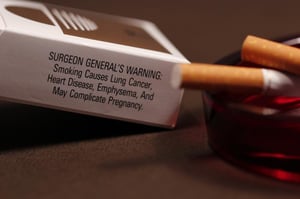 The International Federation of Environmental Health has declared September 26, 2016 World Environmental Health Day, with this year’s theme focused on tobacco control. Child Care Aware® of America and our partners, including the National Environmental Health Association (NEHA), are focusing specifically on the negative health effects of second- and third-hand smoke to both individuals and societies.
The International Federation of Environmental Health has declared September 26, 2016 World Environmental Health Day, with this year’s theme focused on tobacco control. Child Care Aware® of America and our partners, including the National Environmental Health Association (NEHA), are focusing specifically on the negative health effects of second- and third-hand smoke to both individuals and societies.
Second-Hand Smoke
The use of tobacco, as well as the effects of second-hand smoke, have been long documented. According to the Centers for Disease Control and Prevention (CDC), second-hand smoke can cause ear infections, more frequent and severe asthma attacks, and respiratory symptoms and infections. Furthermore, children exposed to second-hand smoke are at a greater risk for sudden infant death syndrome (SIDS). The CDC has provided an overview of second-hand smoke, additional facts, and the health effects on both children and adults on their Smoking & Tobacco Use page.
Third-Hand Smoke
Another effect of cigarette smoke of which you may be less familiar with is third-hand smoke. The Mayo Clinic defines third-hand smoke as residual nicotine and other chemicals left on a variety of indoor surfaces by tobacco smoke. This residue is thought to react with common indoor pollutants to create a toxic mix. This toxic mix of third-hand smoke contains cancer-causing substances, posing a potential health hazard to nonsmokers who are exposed to it, especially children.
This type of smoke clings to hair, skin, furniture, carpets, and other surfaces. Children and infants may be at risk of tobacco-related health problems if they inhale, ingest, or touch items containing third-hand smoke. The only way to protect nonsmokers is to ensure a smoke-free environment in your home, vehicle, hotels, and restaurants.
Consider the following scenario as an example of third-hand smoke.
You operate a family child care program and abide by the state child care regulation that states smoking is not allowed in your home during child care hours. After you close your program for the day, your husband returns home from his job. If the weather is nice enough, he goes outside to smoke a couple of cigarettes in the evening, but when cold winter temperatures arrive, he stays indoors to smoke.
 Young children inhale more contaminated dust than adults because they spend time on the floor. If a child care provider, or a member of their household, smokes indoors during non-child care hours, babies and young children may be exposed to third-hand smoke residue as they crawl on rugs, carpets, and furniture or use smoke contaminated play materials (think of infants and toddlers who put everything in their mouth).
Young children inhale more contaminated dust than adults because they spend time on the floor. If a child care provider, or a member of their household, smokes indoors during non-child care hours, babies and young children may be exposed to third-hand smoke residue as they crawl on rugs, carpets, and furniture or use smoke contaminated play materials (think of infants and toddlers who put everything in their mouth).
Policies and Standards for Child Care
The National Resource Center for Health and Safety in Child Care and Early Education has developed standards focused on health policies and protection in child care, focused on tobacco. This collection of standards and guidelines represent the best evidence, expertise, and experience in the field and can provide you and your program with ideas, tips, and advice on eliminating smoke and its harmful effects from the children in your care.
Both second- and third-hand smoke is a concern for children, families, and child care providers alike. For more information about the dangers of smoking and for resources on quitting tobacco, visit BeTobaccoFree.gov.
Join Child Care Aware® of America and others as we build awareness around tobacco control on World Environmental Health Day. Visit the World Environmental Health Day website for more information, and follow us on Twitter (@USAChildCare) for the latest facts and resources on second- and third-hand smoke.






